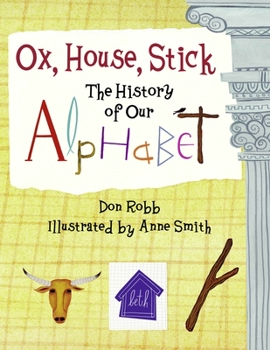Ox, House, Stick: The History of Our Alphabet
Select Format
Select Condition 
Book Overview
Bold collage illustrations and clear prose trace the origins of our familiar letters. From the proto-Sinaitic peoples, through the Phoenicians, Greeks and Romans, this book follows the development of... This description may be from another edition of this product.
Format:Paperback
Language:English
ISBN:1570916101
ISBN13:9781570916106
Release Date:July 2007
Publisher:Charlesbridge Publishing
Length:48 Pages
Weight:0.60 lbs.
Dimensions:0.2" x 8.3" x 10.9"
Age Range:8 to 12 years
Grade Range:Grades 3 to 7
Customer Reviews
3 ratings
Great for bilingual kids
Published by Thriftbooks.com User , 15 years ago
I bought this book for my niece, but also read it myself. I have an advanced degree in linguistics so the alphabet is more than just a passing interest. This book was informative and helpful, without being too detailed or unreadable. Since she's growing up in a bilingual household, she often asks me questions about language comparisons and this book has sparked a whole new series of inquiries. Not that she'll follow my academic training, but it's nice to see the little lady stretching her mind with a well-written text on an interesting subject.
Good introduction, not in depth, rebuttal of other review
Published by Thriftbooks.com User , 15 years ago
I had to respond to the assertion by another reviewer that: "the illustrations of women of antiquity attired as present-day observant muslim women, complete with head coverings." There are only three women illustrated in this book, and only one of those is attired as a Muslim woman with her head covered. The other two have no head coverings or face veiling - one has a wreath of leaves and one has an ornate hair style. Overall, I found this book to be a good introduction - though it is not in depth at all and merely glosses over the history of each letter. This is not necessarily a bad thing, and the book is useful for brief introductions, for a starting point, etc. There is a wonderful list of references and further readings on the subject that can be used for more in-depth explanations.
Politicizing children's books
Published by Thriftbooks.com User , 16 years ago
I bought this book for my six year old granddaughter, thinking it would be a good introduction to the study of language. And in some respects, this book is just that. It's readable, copiously and colorfully illustrated, and will interest children of any age from six to sixteen and beyond. That being said, I fail to understand why except in one small aside, the term "Hebrew" is not even mentioned except in an aside where it is implied as being developed contemporaneously with the arabic alphabet, despite the fact that the Hebrews may indeed have invented what Anne Smith chooses to call the Phoenician alphabet. The date of this invention by Semitic people is generally agreed upon circa 2000 BCE. By 1000 BCE, the Phoenicians had a distinct alphabet which was virtually identical to the Hebrew alphabet of the same period. The arabic language was at that time not an element in the developing Hebrew/Phoenician alphabet. In fact, the arabic alphabet as far as is known did not exist before, at the very earliest, 500 BCE and derives from the Nabateans, and the first presently existing example of the arabic alphabet dates from 200 BCE. It is simply not known whether the Phoenicians borrowed the new, highly flexible and efficient alphabet from the Hebrews or some other Semitic foreign workers in Egypt, or the Hebrews from the Phoenicians. Instead of saying "Hebrew," author Smith chooses to refer to the people living in the traditional Hebrew homeland as "Sinaitic." This is despite the discovery of the so-called "Gezer Calendar" at an ancient Hebrew city in what is now southern Israel, which is written in the earliest Hebrew alphabet (virtually indistinguishable at that point in time from the Phoenician) and signed personally by its author, a man named Abijah who was almost certainly a Hebrew living in Gezer circa 900 BCE, or at the approximate time of the Hebrew king Solomon. And, while we know the names of the Hebrew letters as they existed in 900 BCE, the names of the Phoenician letters for the most part have to be assumed from the Hebrew names. But what I most object to in this book are the illustrations of women of antiquity attired as present-day observant muslim women, complete with head coverings. There is even an illustration of a face-veiled Roman woman beside a man who is dressed in Roman attire including a laurel wreath around his head. As far as can be ascertained, Roman women did not usually cover their faces. They are invariably depicted without head or face coverings in the numerous mosaics and paintings dating from the Roman period. In fact, Roman women are usually portrayed during that period with no head coverings at all, but with fairly elaborate coifeurs. They may have worn a stole over the head in cooler weather, which no doubt could have been used as a partial face covering if the situation demanded it; but to the best of my knowledge, the only habitually veiled Roman women were the Vestal virgins. I fail to understand wh





